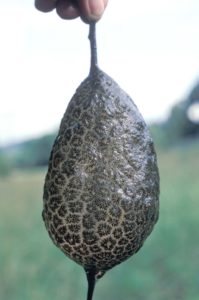
Bryozoans spp.
More Info & Photos of Bryozoans
Management Options
Bryozoans are a food source to fish, insects and snails. They also clean the water as they consume microorganisms, which typically results in good water quality. Due to their positive impact on ponds, removal is unnecessary. Management options listed below are for individuals seeking removal for aesthetic or appearance purposes.
Chemical Control Options
Always read the product label for directions and precautions, as the label is the law. Click on the name of the product to see the label. Read the label for specific water use restrictions.
The active ingredients that have been successful in treating bryozoans include:
- Copper Sulfate
- Copper Chelated Complexes
1) Copper Sulfate
Copper Sulfate or “blue stone” is probably the most commonly used algal treatments because of its availability and low cost. Copper sulfate comes in several forms depending on how finely it is ground. Smaller crystals will dissolve easier than larger crystals. In very hard water it is difficult to use copper sulfate because it binds with the calcium, precipitates out of solution, and renders the copper ineffective as an algaecide.
All copper compounds can be toxic to fish if used above labeled rates and can be toxic in soft or acidic waters even at label rates. Before using copper it is best to test the pond water’s alkalinity and adjust copper treatments to alkalinity concentrations. For additional information on using copper sulfate see the SRAC #410 Calculating Treatments for Ponds and Tanks.
Common trade or product names include but are not limited to:
2) Copper Complexes
All copper compounds can be toxic to fish if used above labeled rates and can be toxic in soft or acidic waters even at label rates. Before using copper it is best to test the pond water’s alkalinity and adjust copper treatments to alkalinity concentrations. For additional information on using copper sulfate see the SRAC #410 Calculating Treatments for Ponds and Tanks.
Common trade or product names include but are not limited to:
Precautions
One danger with any chemical control method is the chance of an oxygen depletion after the treatment caused by the decomposition of the dead plant material. Oxygen depletion can kill fish in the pond. If the pond is heavily infested with weeds it may be possible (depending on the herbicide chosen) to treat the pond in sections and let each section decompose for about two weeks before treating another section. Aeration, particularly at night, for several days after treatment may help control the oxygen depletion.
One common problem in using aquatic herbicides is determining area and/or volume of the pond or area to be treated. To assist you with these determinations see SRAC #103 Calculating Area and Volume of Ponds and Tanks.
Many aquatically registered herbicides have water use restrictions (See General Water Use Restrictions).
To see the labels for these products click on the name. Always read and follow all label directions. Check label for specific water use restrictions.
Questions?
If you need assistance, contact the Ag & Natural Resources agent in your county or hire a professional.